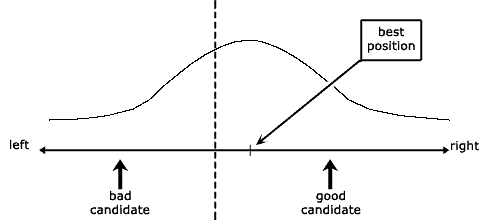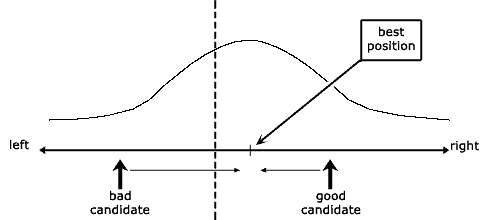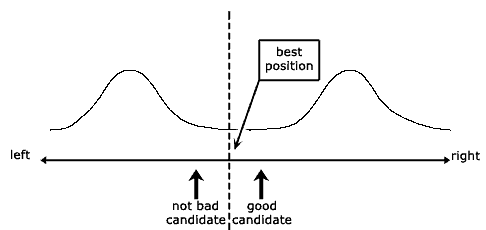
The dividing line shows where the vote splits. Voters to the left of the line will vote for the Good candidate, voters to the right of the line will vote for the Bad candidate.
Of course I don't mean that Left is Good and Right is Bad. The picture works the same way if we flip it around.

Either way, the Good candidate wins, and the election is successful. Some voters are unhappy, but even more voters would have been unhappy if the Bad candidate had won.
In some cases most of the voters may be unhappy with the results. This depends on the shape of the opinion curve. Here is one type of unpleasant outcomes:

In this case the voters' opinions are highly polarized, and the candidates are uncompromising. Almost half the population will be extremely unhappy with the result.
Here is a less unhappy variation:

In this case voters' opinions are highly polarized, but the candidates' positions represent a compromise. Almost all of the voters are relatively unhappy. As unpleasant as these outcomes may seem, they still represent successes of the democratic process. No other choice of leader would have led to a better result.
If we add a third candidate, the democratic process does not even necessarily produce the best result.

In this case the Spoiler candidate takes away enough votes from the Good candidate to allow the Bad candidate to win. This is very likely to happen if there are three parties.
In a many-party system, the voters are more likely to be happy with the choice of candidates, because they can find a candidate that is close to their own position. Unfortunately, the voters are less likely to be happy with the result of the election, because it will not necessarily choose the Best candidate. This situation is even worse when there are many viable candidates.

In a multiple party vote, each voter will be able to choose a candidate with opinions close to his or her own, but the candidate who gets elected will be the one that has the broadest constituency, not the one who best represents the will of the all the voters. Because the worst candidates pick up the outliers, it is relatively easy for a very bad candidate to win.
Let's go back to the case of only two parties.

If the candidates are willing to be flexible, then either candidate can gain votes by moving toward the Best Position. The Best Position is where an equal number of voters are to the left and to the right. A candidate in the Best Position is unbeatable. A candidate in the Best Position also does the best job of making the voters happy, or at least making them less unhappy than they would be otherwise.

If the candidates have some flexibility in their opinions and good information about what the voters want, they will move their own positions towards the Best Position, because it increases their chances of being elected. The closer one candidate moves towards the Best Position, the closer the other candidate will have to move to remain electable. With good pre-election polling, both candidates will be able to determine very accurately how much they need to move. If they are both willing to adjust their positions near the Best Position the outcome of the race will depend on the accuracy of the polling. If the polling is perfect, all elections will end in near ties.
This process of adjusting position in response to polling may seem to compromise the integrity of the candidate, but it does produce candidates whose opinion is very close to the Best Position. This may be regarded as a successful outcome, because a candidate in the Best Position also does the best job of making the voters happy.
Actually, a winner in the Best Position doesn't necessarily make many voters happy; it just makes them less unhappy than they would be with a different winner. In the previous illustrations, the best position was also the most popular position. This is not always the case.

In this final example, the voters are polarized and the Best Position is highly unpopular. Still, it represents the most electable position, and also the position that makes the fewest people very unhappy. This is the best result that any system can produce.
So in the end, two-party democracy is not necessarily good at giving voters a chance to elect a candidate that they like. If the polls are very accurate and the candidates are flexible, a successful election is likely to produce two candidates whom the voter will regard as equally imperfect. The election results will be very close.
For all its problems, the two-party democracy does a good job of producing and selecting candidates that represent an acceptable compromise between a wide spectrum of opinions. If the process is working well, then by the time of the election many voters may feel that they have very little real choice. This may seem like a failure, but actually it is a sign of success. It means that the system has produced candidates that represent the most acceptable compromise of the conflicting opinions of the voters. If this process has worked perfectly, the results of the election will be a tie. Judging from the recent results of the American presidential election, democracy is working well.



